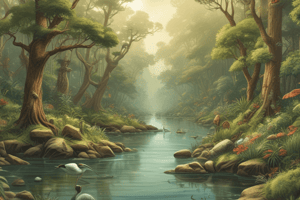Podcast
Questions and Answers
What is the primary reason that energy is lost as it moves up the trophic levels in a food web?
What is the primary reason that energy is lost as it moves up the trophic levels in a food web?
- Organisms use energy for life processes like metabolism and cellular respiration
- Energy is used by organisms to capture and digest food
- Consumers typically do not consume the entire organism
- Heat is released as a byproduct of chemical processes in organisms (correct)
According to the 'Ten Percent Law', approximately what percentage of energy is transferred from one trophic level to the next higher level?
According to the 'Ten Percent Law', approximately what percentage of energy is transferred from one trophic level to the next higher level?
- 50%
- 5%
- 10% (correct)
- 20%
Which of the following best represents the energy pyramid in an ecosystem?
Which of the following best represents the energy pyramid in an ecosystem?
- An inverted pyramid, with more energy at higher trophic levels
- A pyramid with equal levels, representing equal energy distribution
- A pyramid with decreasing levels, representing decreasing energy availability (correct)
- A cylinder, with consistent energy availability at all trophic levels
What is the primary reason for the decreasing levels in the energy pyramid?
What is the primary reason for the decreasing levels in the energy pyramid?
Which of the following statements about energy transfer in an ecosystem is true?
Which of the following statements about energy transfer in an ecosystem is true?
What happens to the energy that is not immediately used by an organism's cells?
What happens to the energy that is not immediately used by an organism's cells?
Which of the following best describes the relationship between energy availability and trophic levels?
Which of the following best describes the relationship between energy availability and trophic levels?
Which of the following is NOT a reason why energy is lost as it passes to the next trophic level?
Which of the following is NOT a reason why energy is lost as it passes to the next trophic level?
What is the primary reason for the difference in shape between the terrestrial and ocean energy pyramids?
What is the primary reason for the difference in shape between the terrestrial and ocean energy pyramids?
Which of the following processes does NOT contribute to the loss of energy as it moves up the trophic levels?
Which of the following processes does NOT contribute to the loss of energy as it moves up the trophic levels?
Flashcards are hidden until you start studying
Study Notes
Feeding Relationships in Ecosystems
- Ecosystems consist of organisms linked through feeding relationships, with energy flowing from primary producers to various consumers.
- Feeding relationships are categorized as food chains and food webs; a food chain is a linear sequence of energy transfer, while food webs represent more complex interconnections.
Primary Producers
- Producers are organisms that utilize light energy to synthesize organic matter via photosynthesis.
- They convert solar energy into chemical energy, are primarily chlorophyll-containing plants, and include algae and some bacteria.
- Autotrophs are self-feeders, playing a critical role in supplying energy and oxygen to the ecosystem.
Photosynthesis Process
- Photosynthesis begins when sunlight hits chlorophyll in leaves.
- Water and nutrients are absorbed by roots; carbon dioxide enters through stomata.
- Major events of photosynthesis:
- Sunlight is transformed into chemical energy.
- Water breaks down, releasing oxygen.
- Carbon dioxide is converted into glucose.
- Plants use glucose for energy; any excess glucose is stored.
Differences Between Photosynthesis and Cellular Respiration
- Photosynthesis is anabolic (building up), while cellular respiration is catabolic (breaking down).
- Photosynthesis utilizes chlorophyll, produces glucose and oxygen, and occurs in light.
- Cellular respiration breaks down glucose, releases carbon dioxide and water, and occurs in all living cells.
Chemosynthesis
- Chemosynthesis is performed by certain bacteria using energy from inorganic chemical reactions instead of sunlight to produce food.
- Common in extreme environments, e.g., hydrothermal vents, where hydrogen sulfide is oxidized to produce sugars and other byproducts.
Decomposers and Nutrient Cycling
- Decomposers break down dead organisms (detritus), recycling nutrients back into the ecosystem.
- Important decomposers in aquatic environments include bacteria, fungi, marine worms, and sea slugs.
Food Chains and Food Webs
- Food chains illustrate the transfer of energy and matter between organisms and highlight energy loss during each transfer through processes like respiration.
- A food chain starts with a producer and ends with decomposers, demonstrating dependencies among organisms.
- A food web encompasses all food chains in an ecosystem, reflecting complex feeding relationships.
Aquatic vs. Terrestrial Food Chains
- Terrestrial and aquatic ecosystems exhibit distinct food chain characteristics while both adhere to the fundamental principles of energy transfer and interactions among organisms.
Studying That Suits You
Use AI to generate personalized quizzes and flashcards to suit your learning preferences.




